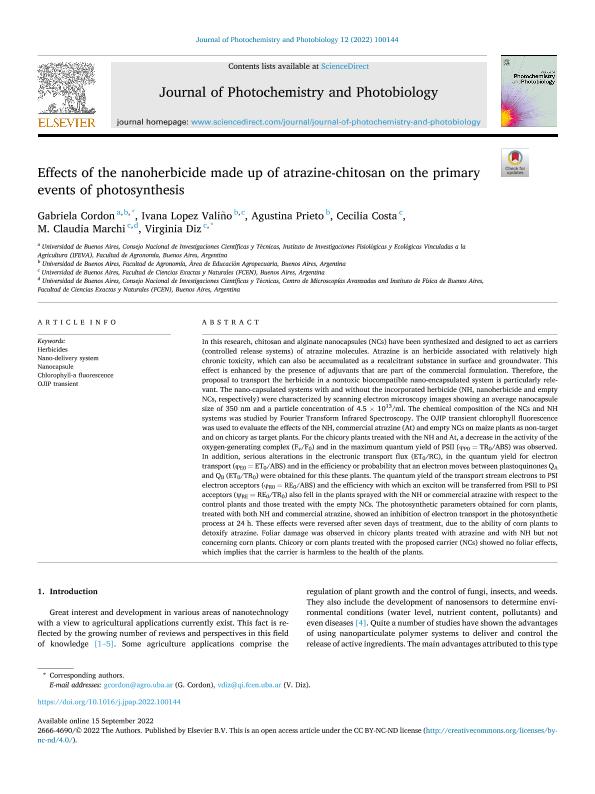Artículo
Effects of the nanoherbicide made up of atrazine-chitosan on the primary events of photosynthesis
Cordon, Gabriela Beatriz ; Lopez Valiño, Ivana; Prieto, Agustina; Costa, Cecilia Daniela
; Lopez Valiño, Ivana; Prieto, Agustina; Costa, Cecilia Daniela ; Marchi, María Claudia
; Marchi, María Claudia ; Diz, Virginia Emilse
; Diz, Virginia Emilse
 ; Lopez Valiño, Ivana; Prieto, Agustina; Costa, Cecilia Daniela
; Lopez Valiño, Ivana; Prieto, Agustina; Costa, Cecilia Daniela ; Marchi, María Claudia
; Marchi, María Claudia ; Diz, Virginia Emilse
; Diz, Virginia Emilse
Fecha de publicación:
12/2022
Editorial:
Elsevier
Revista:
Journal of Photochemistry and Photobiology
ISSN:
2666-4690
Idioma:
Inglés
Tipo de recurso:
Artículo publicado
Clasificación temática:
Resumen
In this research, chitosan and alginate nanocapsules (NCs) have been synthesized and designed to act as carriers (controlled release systems) of atrazine molecules. Atrazine is an herbicide associated with relatively high chronic toxicity, which can also be accumulated as a recalcitrant substance in surface and groundwater. This effect is enhanced by the presence of adjuvants that are part of the commercial formulation. Therefore, the proposal to transport the herbicide in a nontoxic biocompatible nano-encapsulated system is particularly relevant. The nano-capsulated systems with and without the incorporated herbicide (NH, nanoherbicide and empty NCs, respectively) were characterized by scanning electron microscopy images showing an average nanocapsule size of 350 nm and a particle concentration of 4.5 × 1013/ml. The chemical composition of the NCs and NH systems was studied by Fourier Transform Infrared Spectroscopy. The OJIP transient chlorophyll fluorescence was used to evaluate the effects of the NH, commercial atrazine (At) and empty NCs on maize plants as non-target and on chicory as target plants. For the chicory plants treated with the NH and At, a decrease in the activity of the oxygen-generating complex (Fv/F0) and in the maximum quantum yield of PSII (φP0 = TR0/ABS) was observed. In addition, serious alterations in the electronic transport flux (ET0/RC), in the quantum yield for electron transport (φE0 = ET0/ABS) and in the efficiency or probability that an electron moves between plastoquinones QA and QB (ET0/TR0) were obtained for this these plants. The quantum yield of the transport stream electrons to PSI electron acceptors (φR0 = RE0/ABS) and the efficiency with which an exciton will be transferred from PSII to PSI acceptors (ψRE = RE0/TR0) also fell in the plants sprayed with the NH or commercial atrazine with respect to the control plants and those treated with the empty NCs. The photosynthetic parameters obtained for corn plants, treated with both NH and commercial atrazine, showed an inhibition of electron transport in the photosynthetic process at 24 h. These effects were reversed after seven days of treatment, due to the ability of corn plants to detoxify atrazine. Foliar damage was observed in chicory plants treated with atrazine and with NH but not concerning corn plants. Chicory or corn plants treated with the proposed carrier (NCs) showed no foliar effects, which implies that the carrier is harmless to the health of the plants.
Archivos asociados
Licencia
Identificadores
Colecciones
Articulos(IFIBA)
Articulos de INST.DE FISICA DE BUENOS AIRES
Articulos de INST.DE FISICA DE BUENOS AIRES
Citación
Cordon, Gabriela Beatriz; Lopez Valiño, Ivana; Prieto, Agustina; Costa, Cecilia Daniela; Marchi, María Claudia; et al.; Effects of the nanoherbicide made up of atrazine-chitosan on the primary events of photosynthesis; Elsevier; Journal of Photochemistry and Photobiology; 12; 12-2022; 1-11
Compartir
Altmétricas



